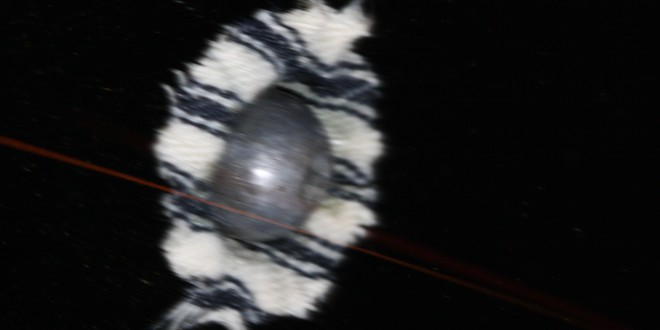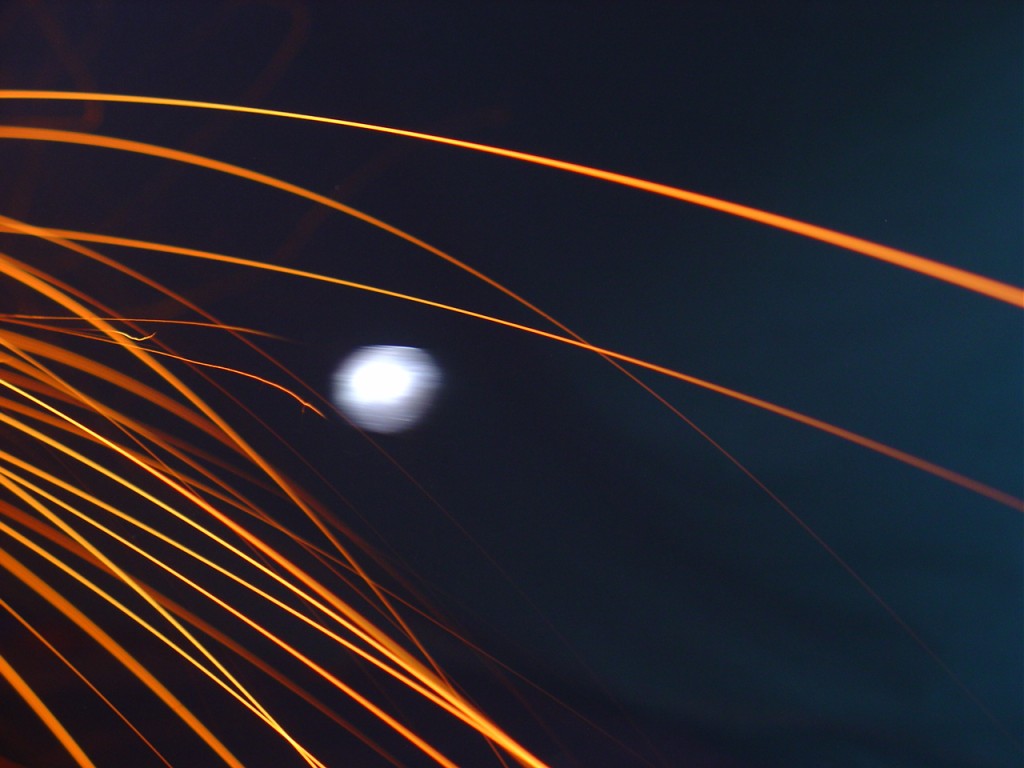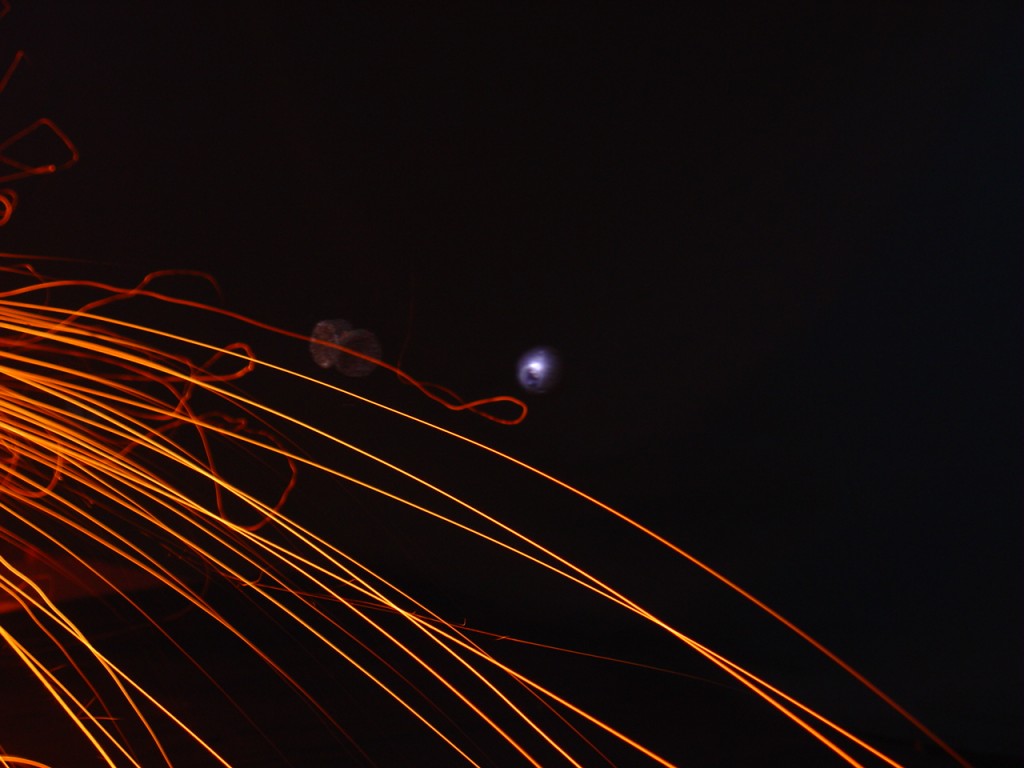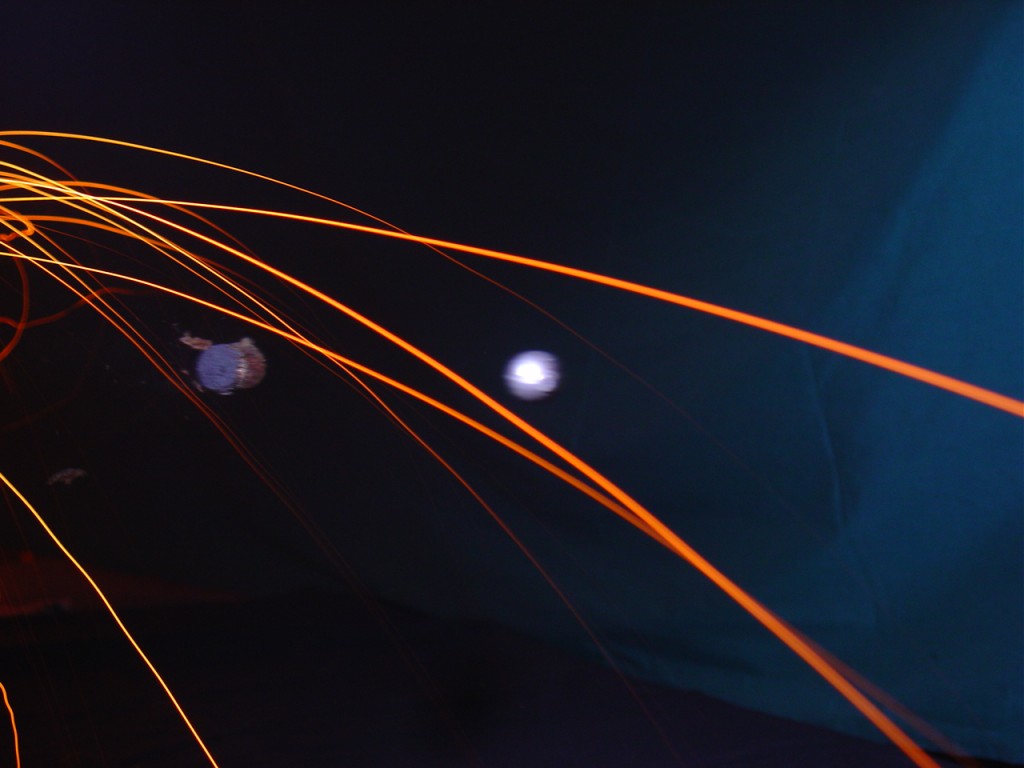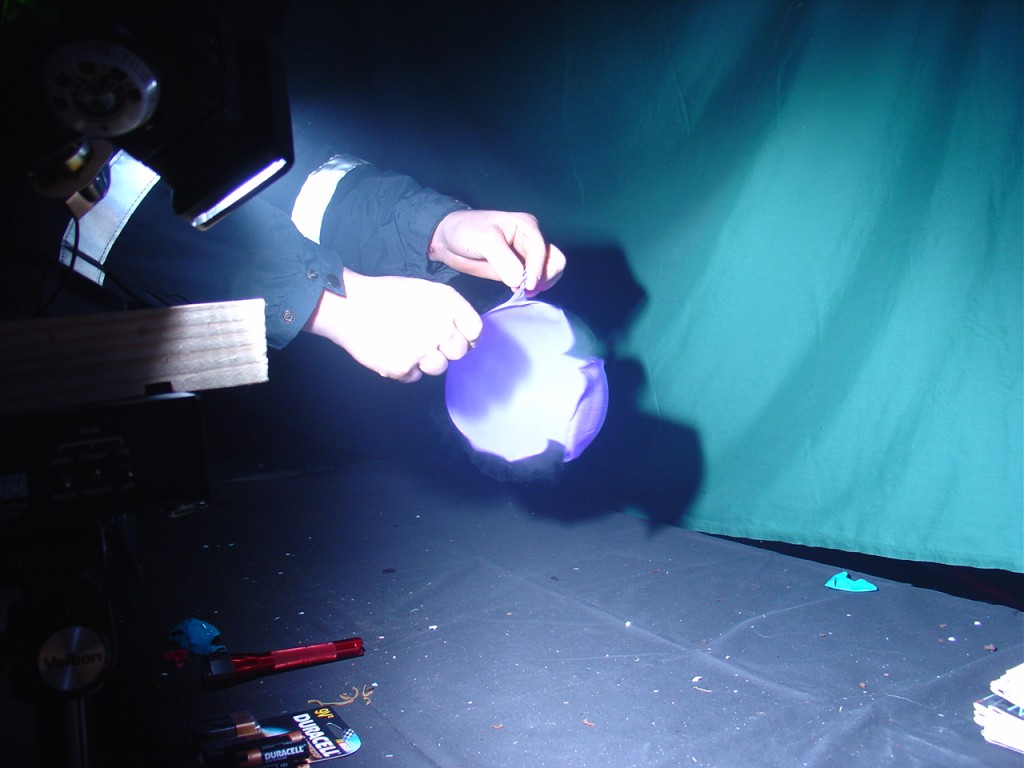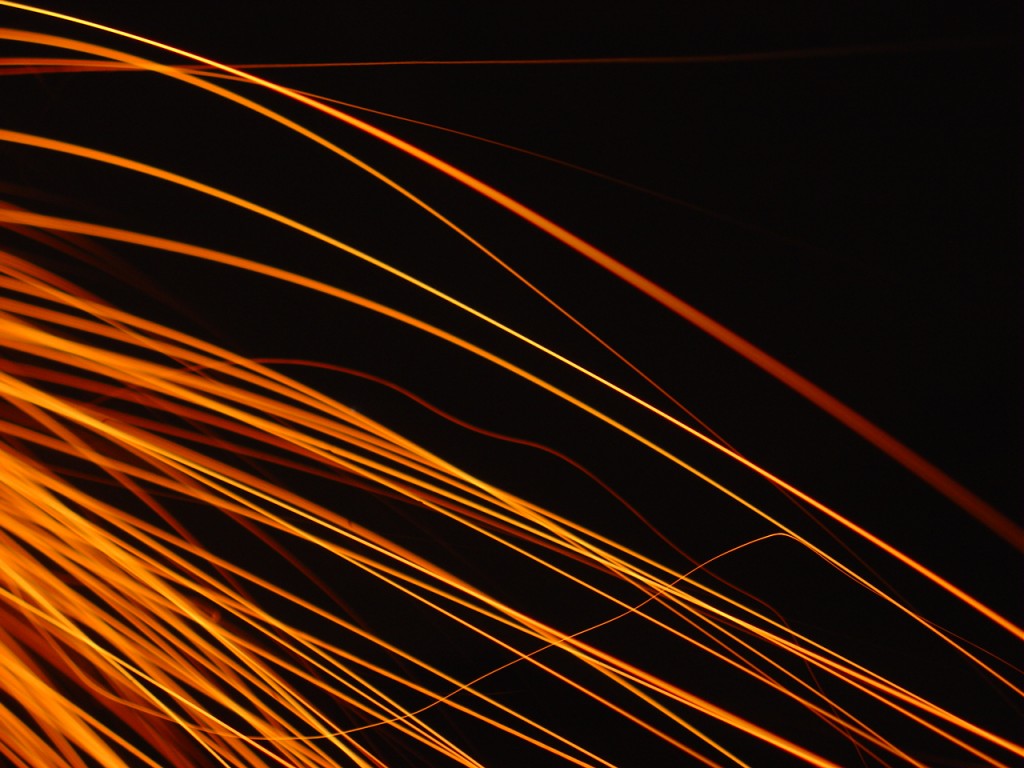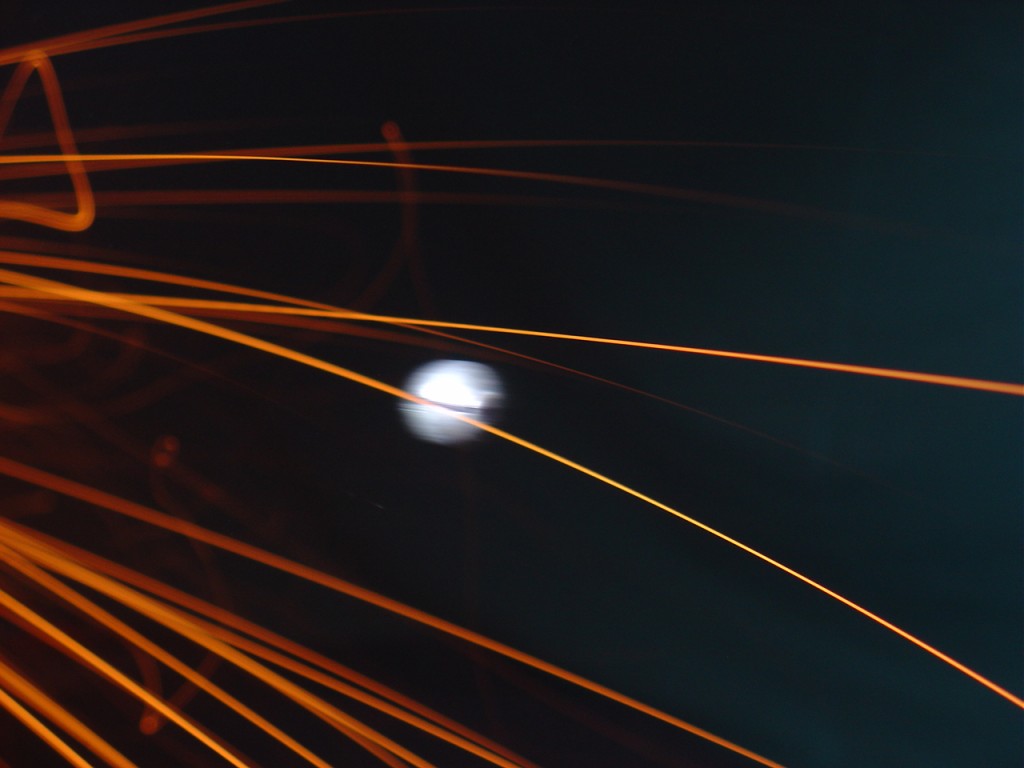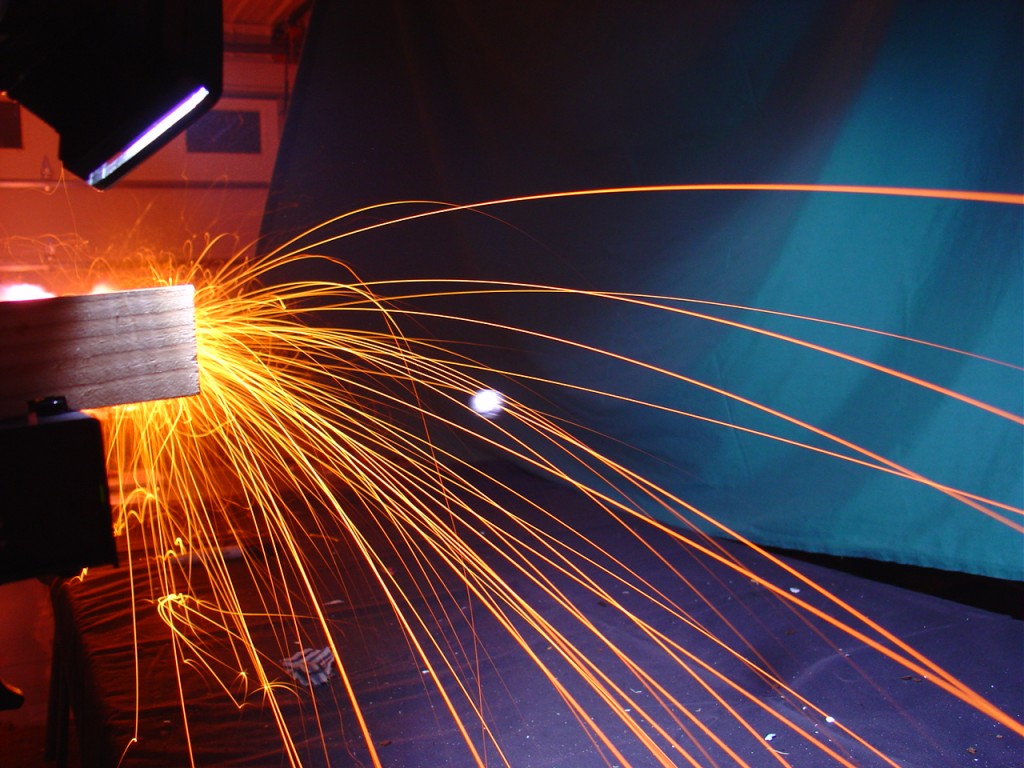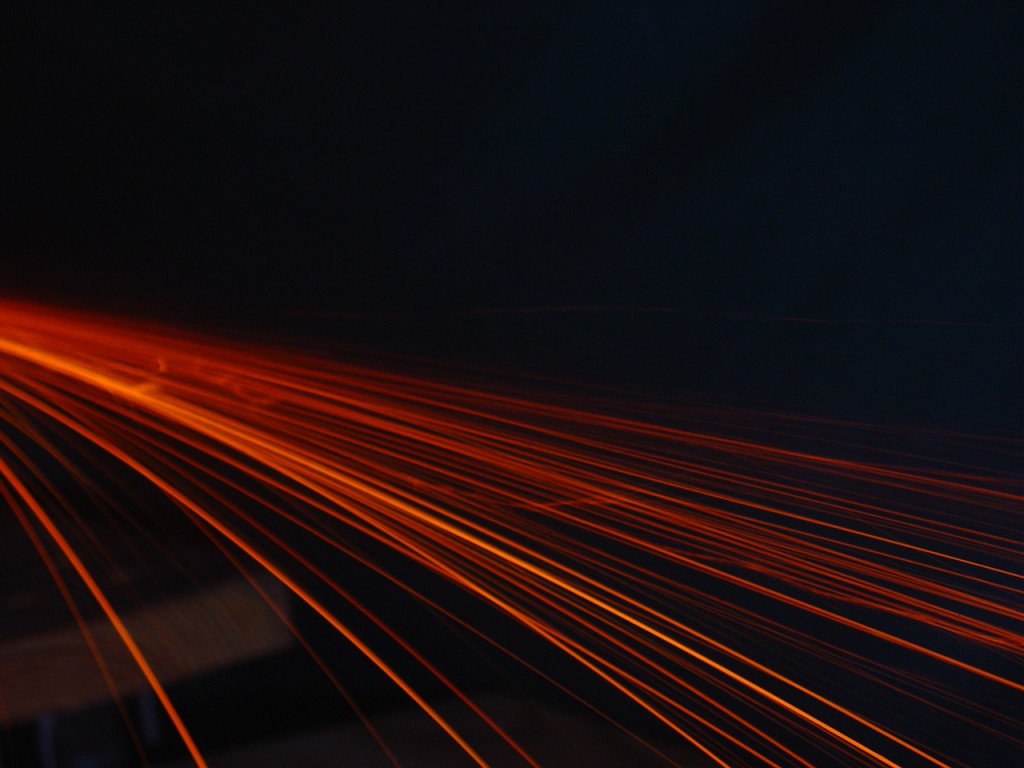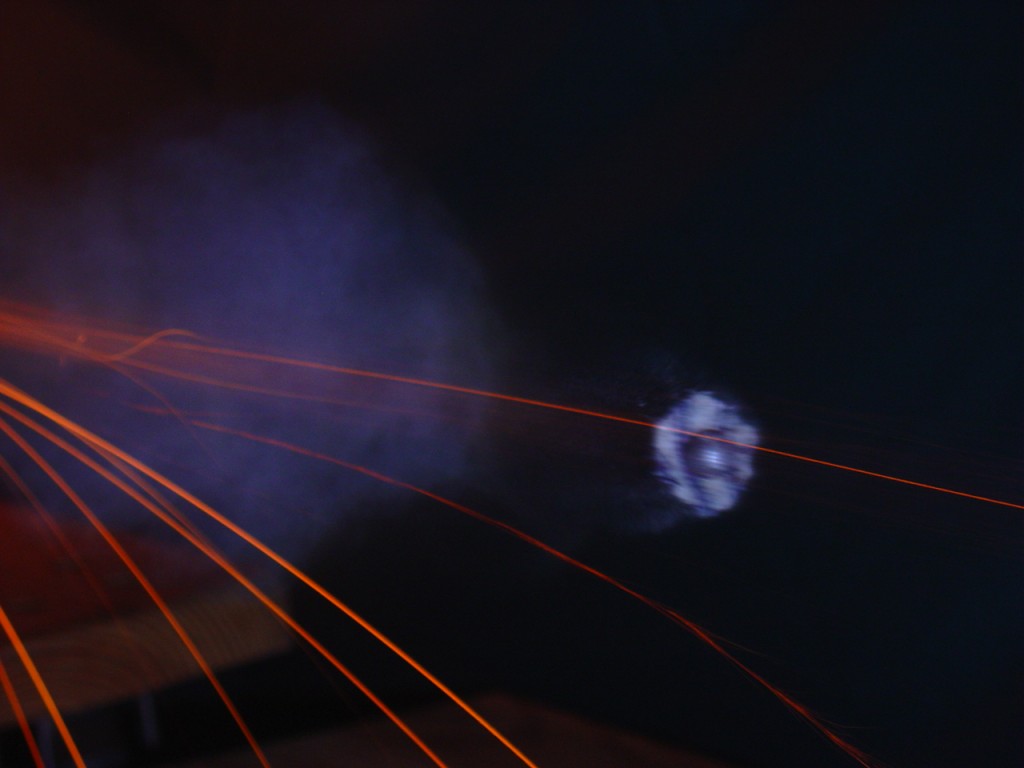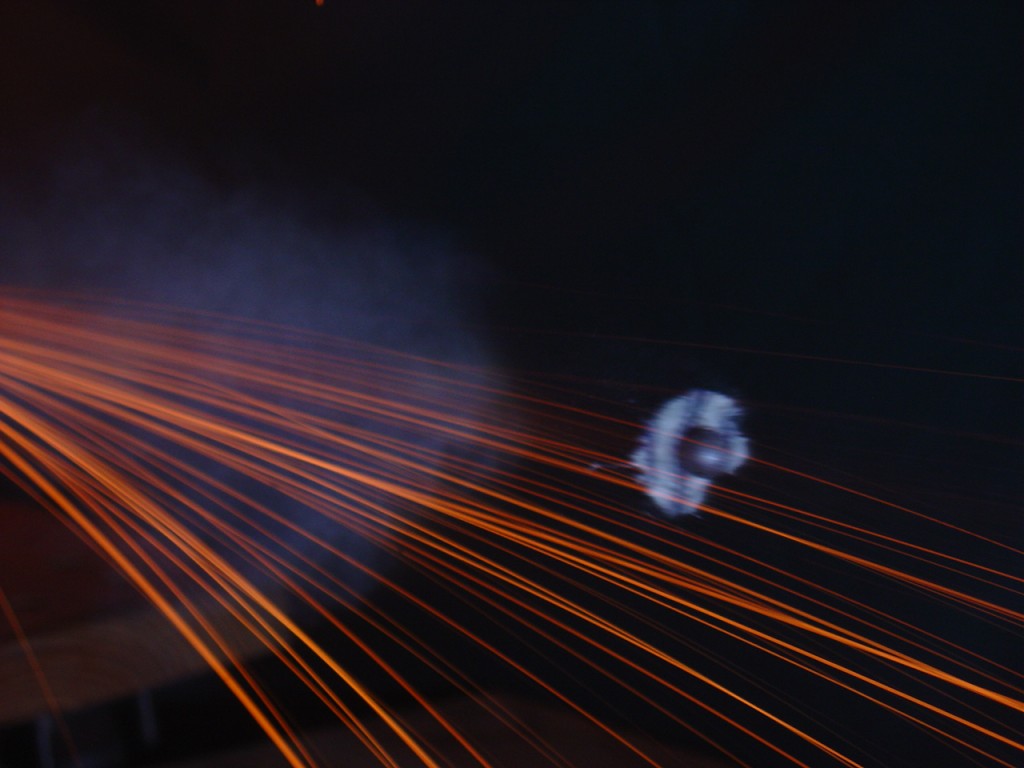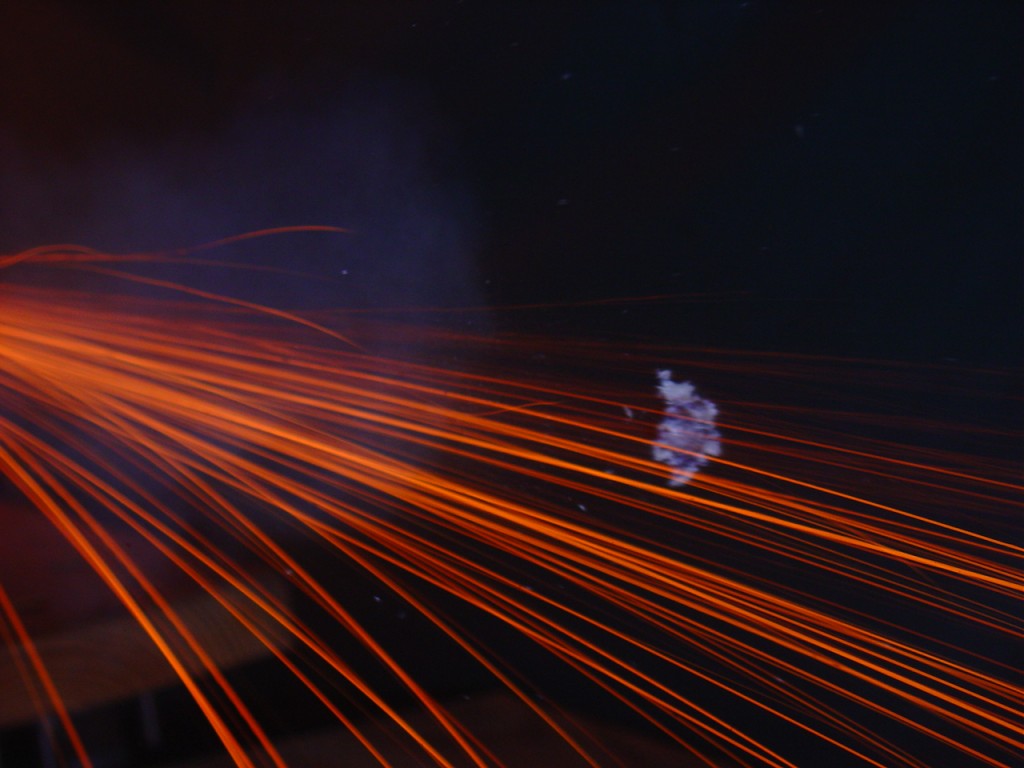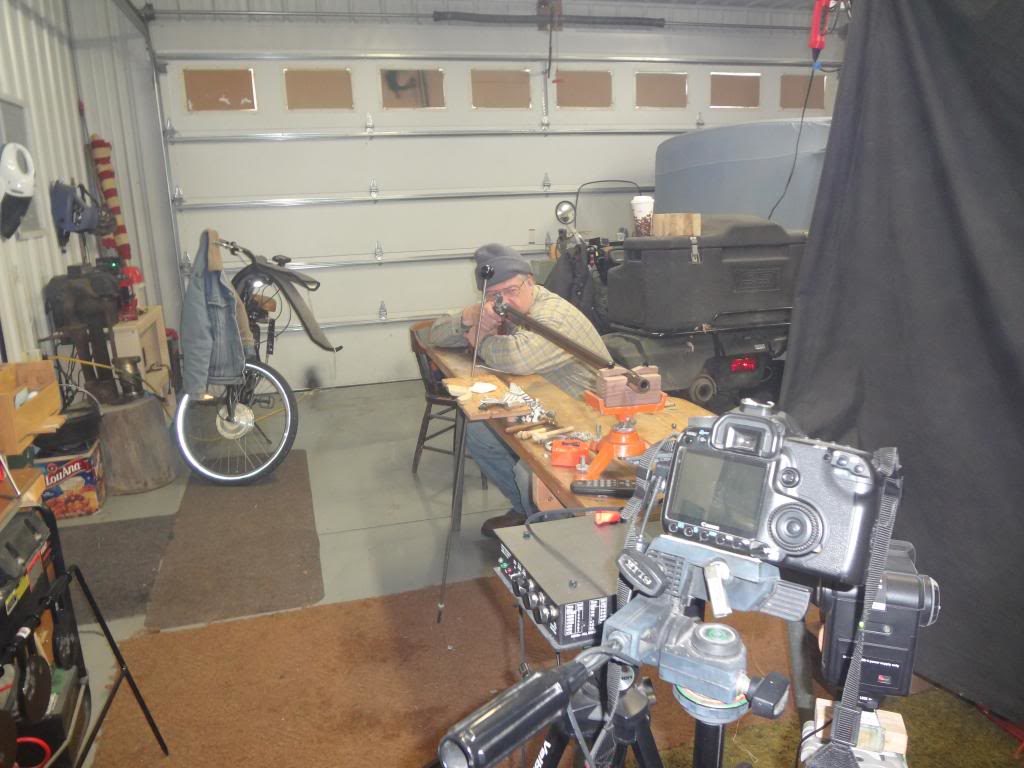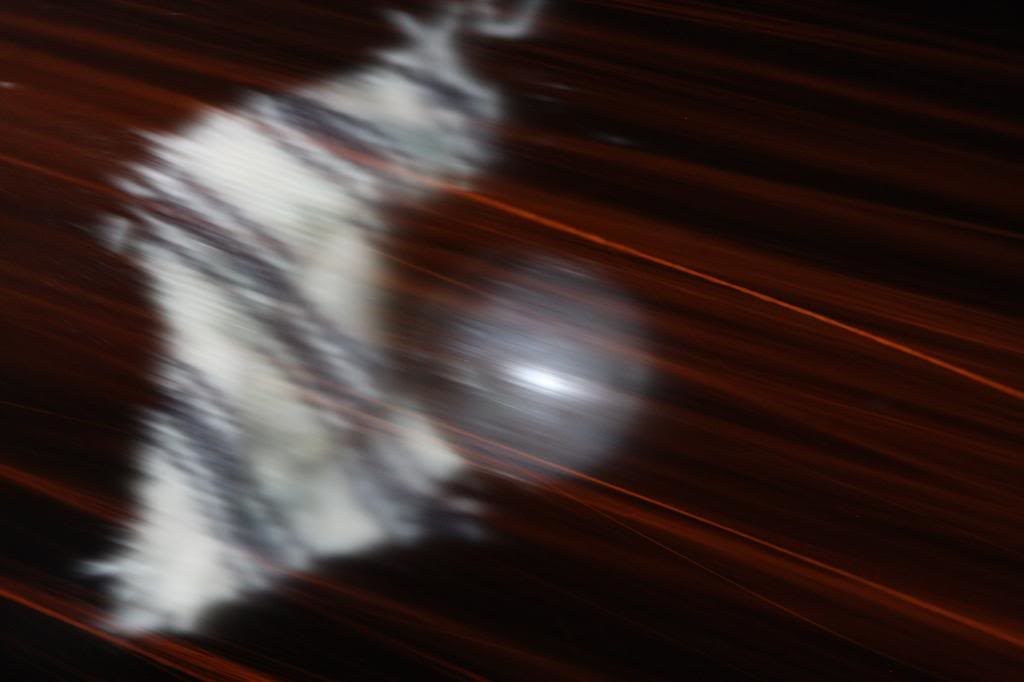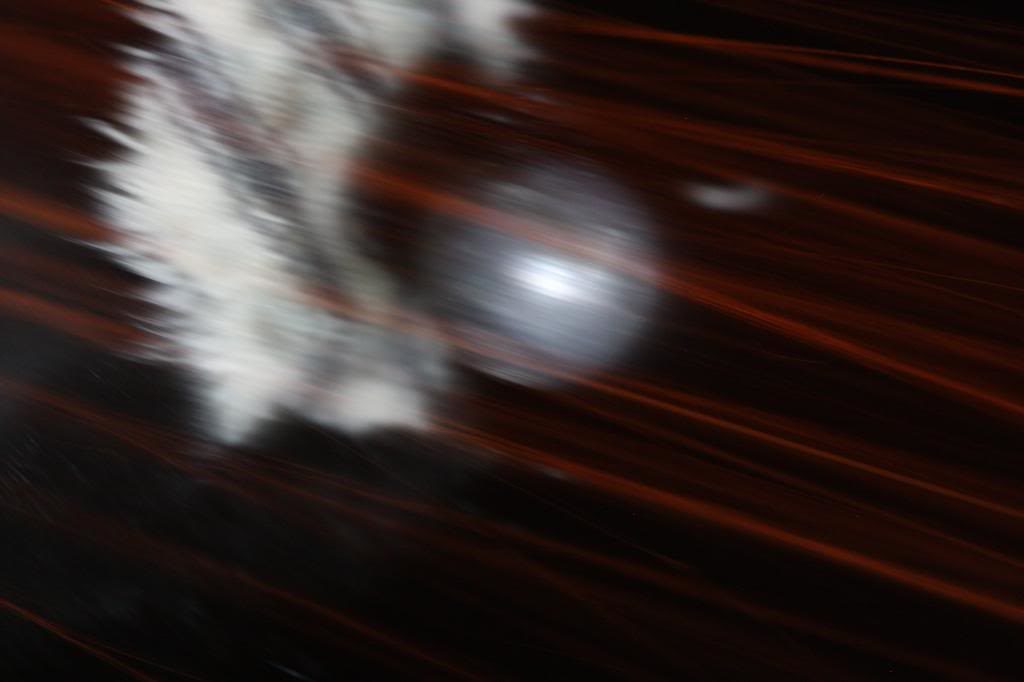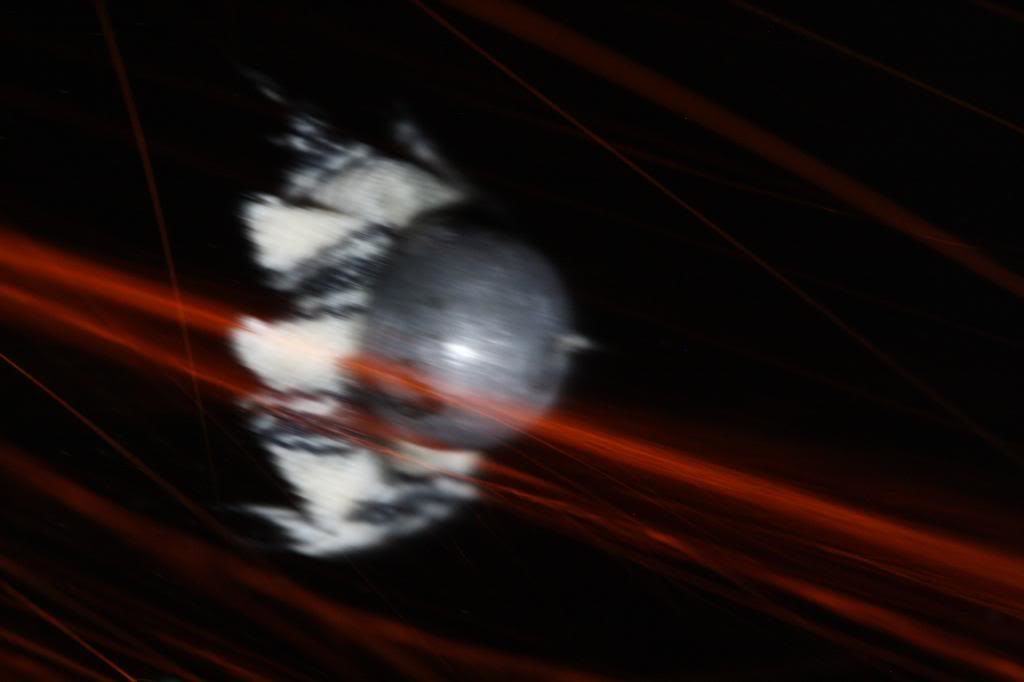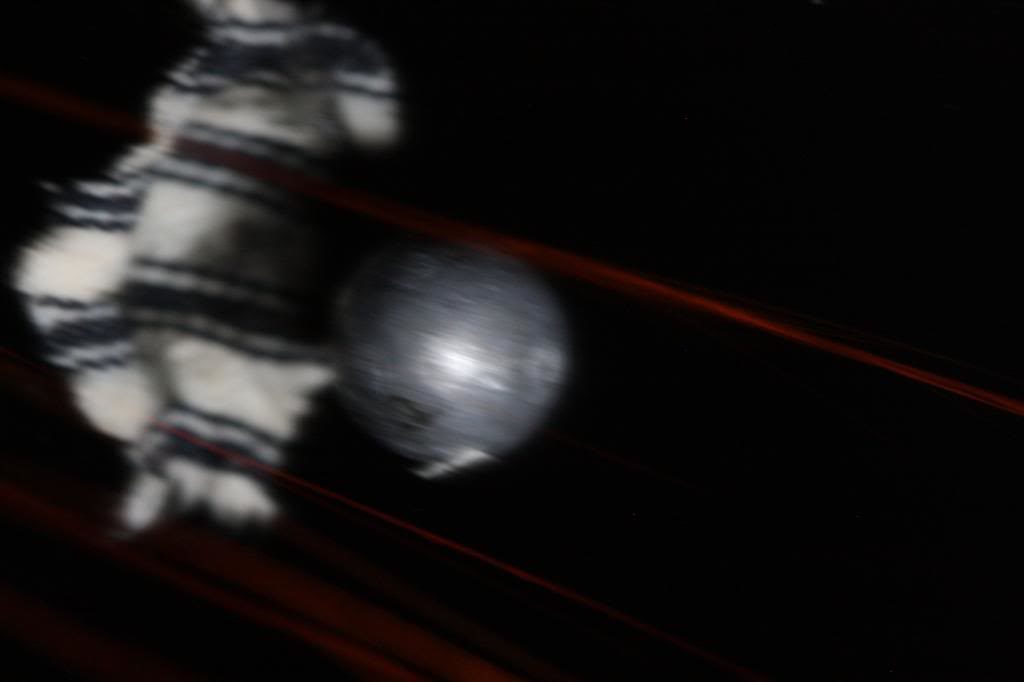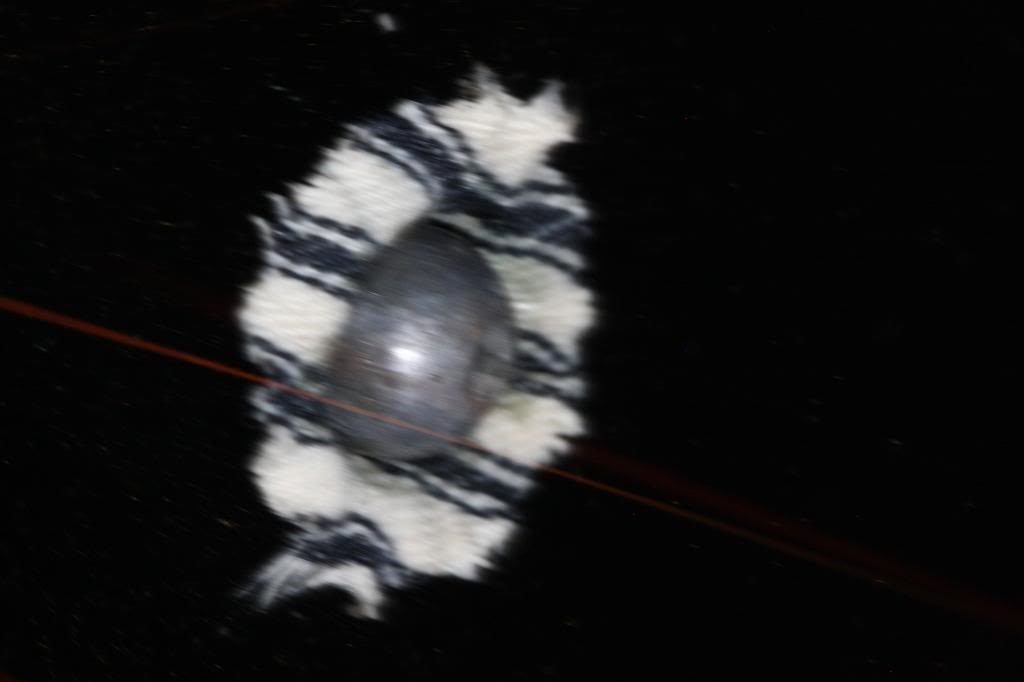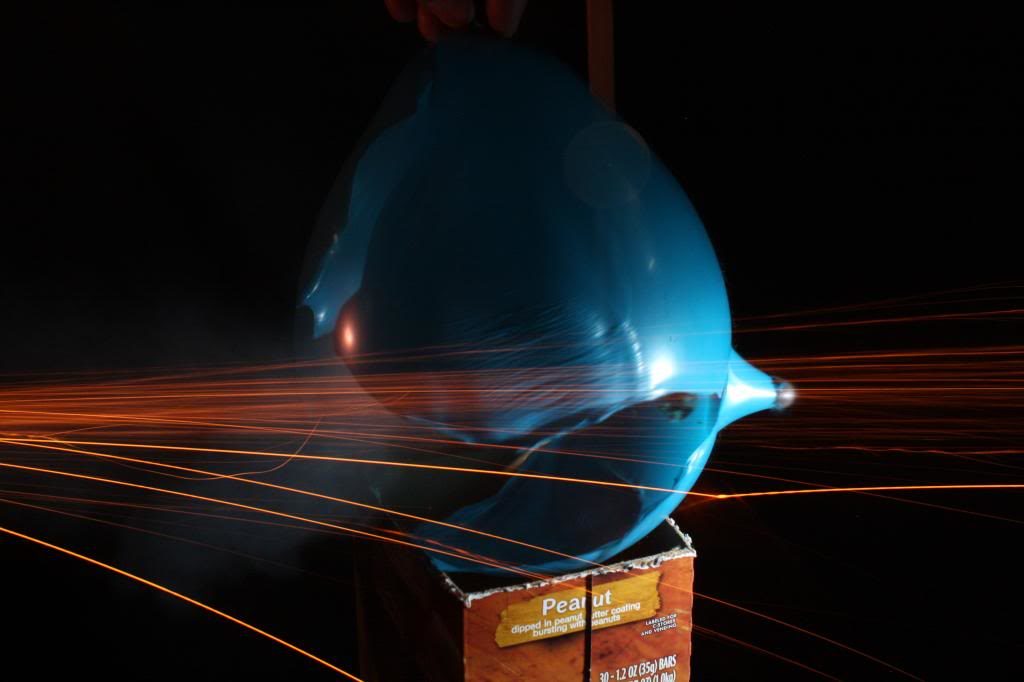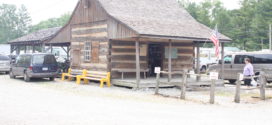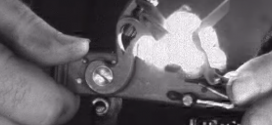Black Powder Photography — editor, Larry Pletcher
(The title photo was taken in January 2014 using the same methodology, but with a close-up lens.)
For some time I have wanted to take a high speed photo of a patched ball from a flintlock muzzleloader shedding its patch. This article documents the six month process of my attempts. Included are all the mistakes I made and what I learned about black powder as a result.
Jan. 11, 2006:
Today I video taped an experiment at the range to prepare for the “patched ball” photo. I wanted to see if I could tell about how far from the muzzle the patch began to separate. When shooting from the kneeling position, I found the patch about 12 feet away from the muzzle. The actual separation was undoubtedly a little closer than that. Off the bench I’ll start with the camera aimed about 10 feet from the muzzle and see whether the patch has separated.
I also tried the magazines as a bullet stop. At about 15 feet, the ball penetrated the fourth magazine. That should give me adequate ability to stop the ball. The stop will need checking after each shot. Blue insulation board will be used to prevent bouncing off the magazines. I don’t think this is necessary, but will err on the safe side.
The gun used is a 20 ga flint trade gun. The load tried today is 25 gr. fffg followed by an over-powder wad soaked in Crisco. The patched .595 ball is seated on the wad. The sound of this load is pretty weak.
Jan. 12, 2006:
Today the physical setup was completed. The infrared beam is ready. I can break the beam with a pencil and cause a flash. The shooting bench is set to give distances of 10, 11, and 12 feet from the beam. With the flintlock on the muzzle rest and aimed at the center of the stop, the ball will break the beam. The bullet stop has four times as many magazines as is necessary.
The next step is to actually fire the gun and see if the ball breaks the beam and triggers the flash. If that works, the camera will be set to have a shutter opening of 5 seconds of so. With the camera ready, the shooter will be primed. The lights will be shut off. The camera shutter will open, and the shot fired. The flash should have been triggered. The light is turned back on and the photo examined. The gun will be adjusted closer or farther away to get the patch falling away. This will take two people to do — one to do the shooting and the other to handle the camera and lights.
Jan 14, 2006:
Today was a process of prepping the camera and flash. The camera is a Sony Cyber-shot 5.0. It can be adjusted in the necessary ways, but it does require careful adjustments. The following are settings different from normal:
Camera:
- Flash turned off
- Shutter speed open to 5 seconds.
- Auto focus turned off
- Manual focus set to .5 meter.
- Zoom is used but must be set at each session.
Flash:
1. Manually adjusted to 1/16 normal flash. This is variable as we see how the photos look. At first this would appear to be fast enough, in reality it may be too slow. If there is too much blur, I will substitute a variable resistor for the thermister. This allows a shorter flash, in fact the fastest I can get with present equipment. At that speed the flash output may be too dim to light up the ball. Since the resistor is variable, it may be possible to find a setting that solves both issues.
After these settings were done, I adjusted the infrared beam again. With the camera in place, I moved the ball until it broke the beam, causing the flash. I also took a photo of the ball to check the focus. Everything seems to work.
Jan. 18, 2006:
Fig. 1 shows the ball after the patch has been lost.
Fig. 1
Fig.2 shows the patch falling away. The ball is out of the camera view to the right. While I got an image, this session was less than a success. I learned that the patch seems to come off the ball between 8 and 9 feet from the muzzle. This will help us in the next try.
Fig. 2 (This photo was lost in 2013 when the files were damaged and the site rebuilt.)
Jan. 20, 2006:
Ed and I took another set of photos tonight. Both show the ball, no patch, but showing the over-powder wad. The ball in Fig. 3 had a felt marker mark placed on the sprue as a joke. But, the mark shows in the photo. These were taken at 9’3″ from the infrared beam. The over powder wad has apparently solved the problem of smoke covering the ball in flight. The orange lines do show grains of powder still burning after leaving the muzzle.
Fig. 3
Fig. 4
On our next try the distance will be to test the distances between 8 and 9 feet. We feel like we’re gaining on this. Five shots are about all we can do in the garage until the smoke gets too thick.
One key change that was necessary was that the 1/16 flash setting still too long duration. I installed a variable resistor. I adjusted the resistor as fast as I could without making it too dim. This seemed to work. I can still get a little shorter, but will sacrifice amount of light to do it.
My friends Mark, Matt, and Doyle stopped by, and after we finished the patched ball session, we played with bursting balloons. In Fig. 5, Matt is doing the honors. The setup makes this type of photo easy to do.
Fig. 5
Jan. 27, 2006:
Fig. 6
Tonight started well when Doyle brought popcorn. But the photo session was disappointing. Fig. 6 was taken when the flash didn’t cycle. All we got was sparks. The ball is in the center of the photo, but is invisible because there was no flash. Other pics seemed out of focus. Distances varied from 8 to 9 feet, but we couldn’t tell if the patch was on the ball – none of the pics were clear enough to be definitive.
Fig. 7 shows an interesting item. There is a shadow on the ball from a spark that is passing it. I speculate that this shadow is proof that gases expelled from the barrel are able to travel faster than the ball. In order to cast a shadow on the ball the spark has to be located between the flash and the ball. The flash is located slightly ahead of the infrared beam. The spark has to be slightly ahead of the ball to leave a shadow. It is my belief that initially the spark overtakes the ball, but as the spark slows, the ball overtakes it on the way to the bullet stop.
Fig. 7
Fig. 8
Fig. 8 was taken zoomed out and shows part of our photo setup. The rifle muzzle is hidden behind the flash mounting. We got the ball but didn’t learn from this one. The patch seems to separate inside if 8’6″, but we have yet to get a good photo it this.
Jan. 30, 2006:
The session on Friday left a bunch of questions. The duration of the flash is the largest cause, I think. I adjusted the flash duration twice, and each time over adjusted. To solve this I gave it a new graduated adjustment dial. I cut a disk out of wood and marked ¼” increments on the edge. Using Mumford Micro Systems’ Time Machine, I timed each increment. With the results printed out in a chart, I can adjust the flash duration close enough to do repeatable trials. The first 4 positions are so close in duration as to be unusable. However the rest of the dial settings give usable increments. Positions 5-8 yield increments faster than the fastest factory setting of 1/30 full flash. There are 4 more settings between 1/30 and 1/16 full flash. Flash durations slower than these are generally too slow to be of much experimental use.
During this week’s session we will first determine the best flash setting and then get to the business of photographing the separation of patch and ball. While last week’s tries were too blurry to be sure, it is my speculation that we will need to be closer than 8 feet – perhaps 5-6 feet to do this. If that is true, sparks from the muzzle may be a problem. Time will tell.
Feb. 2, 2006:
Tonight we decided to start our photo session with the muzzle 5 ft from the infrared beam. The resulting shot, Fig. 9, was completely filled with sparks. No ball could be seen. The ball should be in the right third of the photo and midway up and down. This photo gives no evidence as to where the patch begins to separate.
Fig. 9
For Fig. 10, we moved the gun back to 6 feet. We hoped to lessen the sparks and see the ball. The result was the same. The sparks were too intense to see the ball whether or not the patch had separated. Again the ball should be in the right third, midway top to bottom.
Fig. 10
In Fig. 11 we moved the gun back to 7 feet. Again the sparks were intense. We can see the ball and tell that the patch had separated, but the sparks prevent us from seeing the patch. In one of these photos we added the over-powder wad to see if it would help to contain the sparks. However, it would be difficult to prove which of these used the wad. There seems to be no way to avoid the sparks problem.
Fig. 11
Our last try of the night, Fig. 12, was done to narrow the distance in which the patch might be separating. We moved the gun to from 7 feet to 6 feet 6 inches, hoping that we could see enough of the ball to tell if the patch had separated.
Fig. 12
It is our opinion that the ball in this photo has no patch. We believe, because of sparks, the ball cannot be seen closer than 6 feet 6 inches, and that by this distance the patch has already separated. We don’t think further photos will catch the patch and ball separating.
Fig. 13
When this project was begun, I believed that smoke would be our enemy. Sparks instead, were our downfall. We can say with authority that, in our experiments, the separation of the patch took place closer to the muzzle than 6 feet 6 inches. At distances closer than this, the sparks produced are too intense to capture the separation in a photo.
Several interesting sidebars came to light during our work:
- At distances from 5-7 feet, the patch imbedded itself into the Styrofoam that made the first layer of the bullet-stop.
- Photos show that some sparks overtake the ball and pass it. They also lose velocity faster than the ball does.
- Smoke never played a part in our work, even though it was considered to be a problem at the outset.
Feb. 24, 2006:
Recent information from a muzzleloading friend means that I need to try the experiment with another powder. William Knight has impeccable credentials in the field of black powder. He recently performed experiments with Swiss, Elephant, and Goex brands of black powder. The experiment consisted of dissolving a measured amount of the various powders and examining the remains. Summarizing his results, Goex powder had 5% of the charcoal remain on top of his screen. Swiss had virtually nothing that did not dissolve.
Mr. Knight related to me that the difference was that the Swiss powder used charcoal that was ground almost to dust. Goex charcoal was not ground that finely. Mr. Knight suggested that the sparks seen in our photos were particles of charcoal burning after leaving the barrel. It was his opinion that Swiss powder would probably have noticeably less sparks.
I purchased a can of Swiss ffg powder and will set up to repeat the experiments. Mr. Knight’s information may still allow us to get a photo of the patch separating from the ball.
March 9, 2006:
Tonight we tried Swiss ffg powder to see if there was a reduction in sparks. Because of a couple of unrelated problems we fired only one shot. The charge was 25 grains of Swiss ffg — just as we had done with the Goex charge. The distance was 6 feet from the infrared beam. The result was a photo with a very substantial reduction in sparks. The photo was a failure from the standpoint of getting the ball on film. But it was a success regarding the powder. Our experience confirms Bill Knight’s findings that Swiss powder contains charcoal ground more finely than Goex charcoal. It also confirms that sparks in the Goex photo are caused by those charcoal particles. The lack of large charcoal particles in the Swiss powder leads us to believe that our goal of a photo of the patch separating from the ball is now finally possible.
Fig. 14 was taken with the Swiss ffg load at 6 feet. Compare this photo with Fig. 10, also taken at 6 feet but with Goex powder. The only variable in these two photos is the powder. The reduction is unmistakable.
Fig. 14
June 6, 2006:
This is the first photo session since changing to the .40 caliber flint rifle. We made the change because of a safety flaw found in the operation of the trade gun. The rifle used tonight has a Siler lock, Douglas barrel, and Davis triggers. I have a high level of confidence in it. The last entry explained the reason of the change to Swiss black powder. As we worked tonight, the noticeable decrease in sparks was extremely helpful. We could photograph the ball more than twice as close as when using Goex.
The procedure used was largely the same as in previous attempts, with the exceptions noted above. The shot is fired in total darkness. The rifle is loaded with 10 grains of Swiss ffg powder and a .395 caliber ball. Breaking the infrared beam triggers the flash. Once everything is ready, the rifle is aimed, lights switched off, camera shutter is opened, rifle is fired, and finally the camera shutter is closed. After examining the resulting digital photo, adjustments are made, and the next shot is prepared.
In Fig. 15, the muzzle of the rifle was 30 inches from the beam. One can see the spacing between the ball and the patch. In Fig. 16, the rifle was moved closer- this time 26 inches from the beam.
Fig. 15
Fig. 16
This photo is indistinct, but does show that the patch and ball are much closer together. We felt that we were on the right track and decided to bring the rifle closer.
Fig. 17
Fig. 18
Our next try, Fig. 17 was fired with the muzzle 24 inches from the beam. In this shot the patch has just separated from the ball, but the distance is so small that the ball still casts a shadow on the patch. After another try at this distance, Fig. 18, we moved the muzzle to 20 inches. At the 20 inch distance, the patch still contacts the ball. We took Fig. 19 and Fig. 20 at this distance. While they each vary slightly, they all show the patch and ball in contact with each other. These photos met our goal at the beginning of the project.
Fig. 19
Fig. 20
We did move to 17 inches to see if the patch could be photographed tightly wrapped around the ball. This last photo shows the patch still wrapped around the ball, but the ball is difficult to see.
Fig. 21
It is interesting to note that there were less sparks at 17 inches with Swiss powder than there were at 60 inches using Goex.
My good friend Ed Harting was the trigger man in all of our trials. It was his job to fire the benched rifle in total darkness. With all equipment ready, Ed would aim the rifle. When he was anchored well, I would turn out the lights and open the camera lens. Ed would then fire the shot. I was probably more comfortable with Ed behind the gun than he was with me out in front. Ed’s barber shop was also the center for the planning of the experimentation and methodology used. We would examine the photos and plot our next session. A fair number of Ed’s customers became actively involved in our progress. Thanks, Ed for your help and support.
(Ed died of cancer since the project was completed. He was a good friend is greatly missed.)
———–
In 2014, Steve Chapman and I decided to duplicate the work Ed and I did earlier. We used a different camera and lens, hoping to get larger images. The title image is one of this later group. Below are more patch/ball images and also photos of the equipment.
And just for fun:
 BlackPowderMag.com Flintlock Rifles and Black Powder Guns
BlackPowderMag.com Flintlock Rifles and Black Powder Guns
